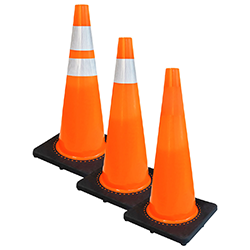Traffic cones are more than just bright, orange markers on the road. They are a versatile tool used in various settings to direct traffic, mark hazardous areas, and ensure safety. But what makes them so indispensable? Read on to discover the many uses and benefits of traffic cones and how they contribute to effective traffic and crowd management.
What Are Traffic Cones?
Traffic cones are cone-shaped markers typically made of plastic or rubber. They are designed to be highly visible, often in bright colors like orange or red, and are used to temporarily redirect traffic or mark hazards. Traffic cones are lightweight, portable, and easy to deploy, making them an essential tool for traffic control and safety management.The Benefits of Traffic Cones
1. Versatile Use Cases: Traffic cones are used in a wide range of scenarios, from directing vehicles during road construction to marking out safe zones at events. Their versatility makes them a go-to solution for temporary traffic management. 2. High Visibility: Designed to be highly visible, traffic cones often feature reflective strips that enhance their visibility in low-light conditions or at night. This visibility is crucial for ensuring that drivers and pedestrians can easily identify restricted areas or hazards. 3. Easy Deployment and Removal: Traffic cones are lightweight and portable, making them easy to deploy and remove as needed. This is especially useful in situations that require quick changes to traffic flow or the marking of temporary hazards. 4. Cost-Effective Solution: Compared to other traffic control devices, traffic cones are a cost-effective option. They require no installation and can be reused multiple times, making them a budget-friendly choice for temporary traffic management. 5. Durability: Modern traffic cones are made from durable materials like PVC, which can withstand harsh weather conditions and repeated use. This durability ensures that they remain functional and effective over time. 6. Flexibility in Application: Traffic cones are not limited to road use. They are also commonly used in parking lots, construction sites, airports, and even indoors for marking hazards or guiding foot traffic.How to Choose the Right Traffic Cones
When selecting traffic cones for your needs, consider the following factors:- Material: Choose cones made from durable materials like PVC or rubber, which can withstand outdoor conditions and heavy use.
- Height and Base Size: The height and base size of the cone should be appropriate for the intended use. Taller cones with wider bases offer more stability and are better suited for high-traffic areas.
- Reflectivity: For use in low-light conditions, opt for cones with reflective strips or bands that enhance visibility.
- Color and Markings: Bright colors like orange, red, and yellow are standard for traffic cones, but some applications may require specific markings or colors to indicate different hazards.
- Weight: Depending on the location and weather conditions, you may need cones with weighted bases to prevent them from being blown over by the wind.

